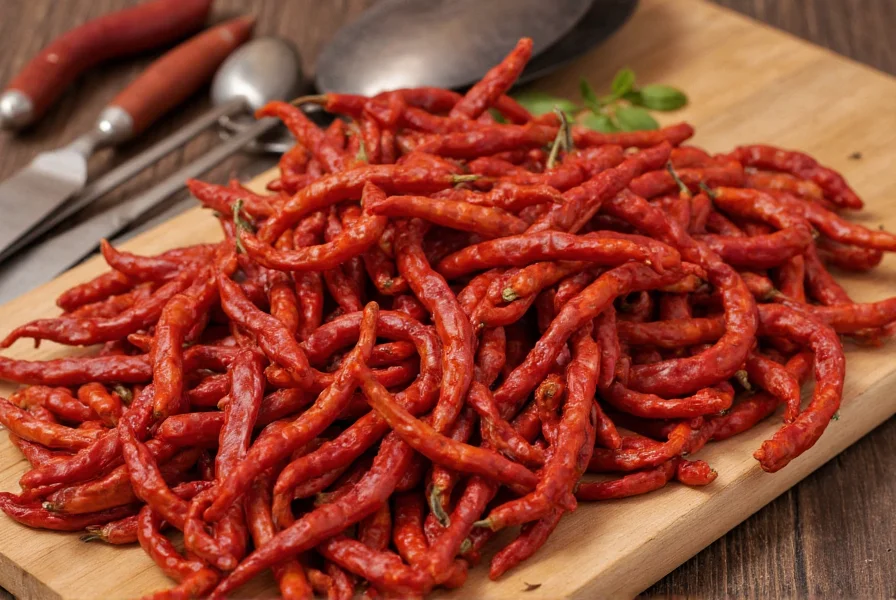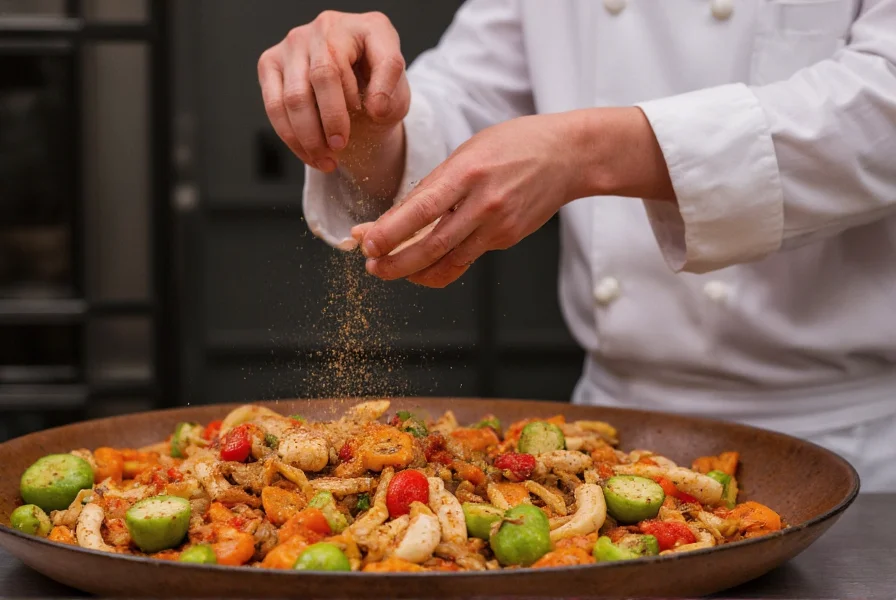Originating from southeastern Turkey's Gaziantep region, corbaci pepper (Capsicum annuum) has been cultivated for centuries by local farmers using traditional sun-drying methods. The name "corbaci" derives from the Turkish word "çorba," meaning soup, highlighting its primary culinary application in traditional Turkish broths and stews. Unlike many commercial chili varieties, corbaci peppers are typically harvested at full maturity, then air-dried naturally under the Anatolian sun for several weeks, which develops their characteristic deep burgundy color and rich flavor profile.
Physical Characteristics and Flavor Profile
Corbaci peppers measure approximately 4-6 inches in length with a tapered shape and relatively thin walls. When fully dried and crushed, they produce a fine, deep red powder that imparts both color and flavor to dishes. The heat level sits comfortably in the medium range, making it accessible to most palates while still providing noticeable warmth. What distinguishes corbaci pepper from similar varieties is its nuanced flavor profile that combines:
- Earthy, almost mushroom-like base notes
- Subtle fruitiness reminiscent of dried cherries
- Delicate smokiness from the sun-drying process
- Minimal bitterness compared to many other dried chilies
| Pepper Variety | Scoville Heat Units | Primary Flavor Notes | Common Culinary Uses |
|---|---|---|---|
| Corbaci Pepper | 2,500-5,000 | Earthy, slightly sweet, subtle smoke | Soups, stews, meat rubs, flatbreads |
| Aleppo Pepper | 10,000 | Fruity, moderate heat, slight acidity | Middle Eastern dishes, salads, dips |
| Urfa Biber | 25,000-50,000 | Smoky, raisin-like, winey | Meat dishes, kebabs, egg dishes |
Traditional Turkish Culinary Applications
In Turkish kitchens, corbaci pepper serves as both a flavor enhancer and natural coloring agent. Unlike many chili varieties used primarily for heat, corbaci pepper's value lies in its ability to add depth and complexity to dishes without overwhelming spiciness. Traditional applications include:
Çorba (Turkish soups): As suggested by its name, corbaci pepper is essential in many regional soup recipes, particularly lentil, yogurt, and meat-based soups where it provides warmth without dominating other flavors.
Kebabs and grilled meats: Mixed with paprika and other spices, corbaci pepper creates the distinctive red hue and flavor base for many Turkish meat marinades and rubs.
Menemen (Turkish scrambled eggs): A pinch of corbaci pepper elevates this classic breakfast dish with subtle warmth and color.
Pide (Turkish flatbread): Often sprinkled on top of cheese or meat pide for both visual appeal and flavor enhancement.
How Corbaci Pepper Differs From Similar Varieties
While often confused with other Middle Eastern peppers, corbaci has distinct characteristics that set it apart. Understanding corbaci pepper vs aleppo pepper differences is crucial for authentic Turkish cooking. Unlike Aleppo pepper which has higher heat and more pronounced fruitiness, corbaci offers a more earthy profile with less acidity. Compared to Urfa biber, which undergoes a unique fermentation process resulting in intense smokiness and higher heat, corbaci provides a milder, more versatile flavor that works well in delicate dishes.
One key distinction in traditional corbaci pepper preparation methods is the absence ofscrição (oil treatment) that characterizes Urfa biber. Corbaci peppers are simply sun-dried and crushed, preserving their natural flavor profile without additional processing.
Where to Find and How to Use Corbaci Pepper
Finding authentic corbaci pepper outside Turkey can be challenging, as it's less commercially distributed than Aleppo or Urfa peppers. Specialty Middle Eastern markets, Turkish grocery stores, and select online spice retailers represent the best sources for where to buy genuine corbaci pepper. When purchasing, look for deep burgundy color and avoid products that appear overly bright red (which may indicate artificial coloring).
For home cooks exploring corbaci pepper substitution options, a 1:1 blend of mild paprika and a small amount of cayenne provides the closest approximation, though it won't fully replicate the unique earthy notes. When using corbaci pepper in cooking:
- Add during the last 10-15 minutes of cooking to preserve flavor
- Store in an airtight container away from light and heat
- Reconstitute dried flakes in warm water for sauces requiring paste-like consistency
- Use 1/4 to 1/2 teaspoon per serving as a starting point, adjusting to taste

Storage and Shelf Life Considerations
Proper storage significantly impacts how long corbaci pepper maintains flavor. Like all dried chilies, it's susceptible to degradation from light, heat, and moisture. For optimal preservation:
- Store in opaque, airtight containers
- Keep in a cool, dark pantry (below 70°F/21°C)
- Consider refrigeration in humid climates
- Use within 6-8 months for peak flavor (though safe indefinitely if properly stored)
Signs of degraded corbaci pepper include faded color, diminished aroma, and loss of flavor complexity. While still safe to consume, aged peppers won't deliver the nuanced taste profile that makes this variety special.
Exploring Corbaci Pepper in Modern Cuisine
Contemporary chefs are discovering innovative applications for corbaci pepper in fusion cooking. Its moderate heat and earthy profile make it suitable for dishes beyond traditional Turkish cuisine:
- As a rub for roasted vegetables
- Infused in olive oil for dipping bread
- Added to tomato-based pasta sauces
- Enhancing chocolate desserts with subtle warmth
- Creating unique spice blends for popcorn or nuts
When experimenting with corbaci pepper culinary applications, remember that its strength lies in complementing rather than dominating other ingredients. Start with small amounts and adjust according to your desired heat level and flavor intensity.

FAQ: Frequently Asked Questions About Corbaci Pepper
Is corbaci pepper the same as Aleppo pepper?
No, corbaci pepper and Aleppo pepper are distinct varieties. Corbaci originates from Turkey with moderate heat (2,500-5,000 SHU) and earthy flavor, while Aleppo pepper comes from Syria with higher heat (10,000 SHU) and more pronounced fruitiness. They're often confused but serve different culinary purposes in traditional cooking.
What dishes pair best with corbaci pepper?
Corbaci pepper excels in Turkish soups (çorba), lentil dishes, meat stews, menemen (scrambled eggs), and as a topping for pide (Turkish flatbread). Its moderate heat and earthy flavor also work well in roasted vegetable dishes, tomato-based sauces, and even some chocolate desserts where subtle warmth is desired without overwhelming spiciness.
How should I store corbaci pepper to maintain freshness?
Store corbaci pepper in an opaque, airtight container in a cool, dark pantry below 70°F (21°C). For extended shelf life in humid climates, refrigeration is recommended. Properly stored, it maintains optimal flavor for 6-8 months, though it remains safe indefinitely if protected from moisture and contaminants.
Can I substitute paprika for corbaci pepper?
Yes, but with adjustments. For the closest approximation, use a 3:1 blend of sweet paprika to cayenne pepper. This mimics corbaci's moderate heat and earthy profile, though it won't replicate the unique sun-dried flavor notes. For authentic Turkish recipes, however, genuine corbaci pepper provides irreplaceable flavor complexity.
Does corbaci pepper have any health benefits?
Like other chili peppers, corbaci contains capsaicin which may offer metabolic benefits and pain relief properties. It's also rich in vitamin C and antioxidants. However, its primary culinary value lies in flavor enhancement rather than specific health claims, and it should be consumed as part of a balanced diet rather than for medicinal purposes.











 浙公网安备
33010002000092号
浙公网安备
33010002000092号 浙B2-20120091-4
浙B2-20120091-4